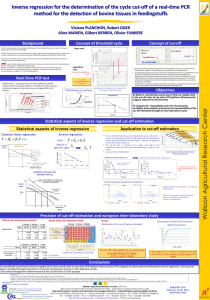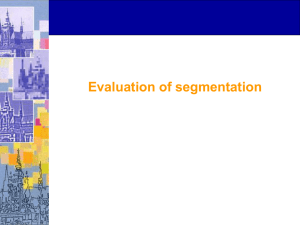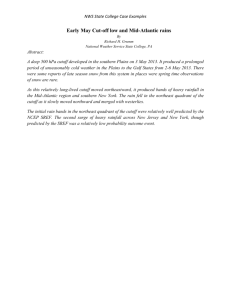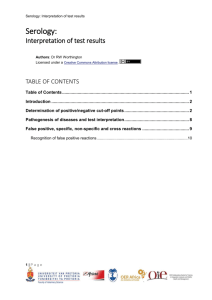Establishing Reference Ranges
advertisement
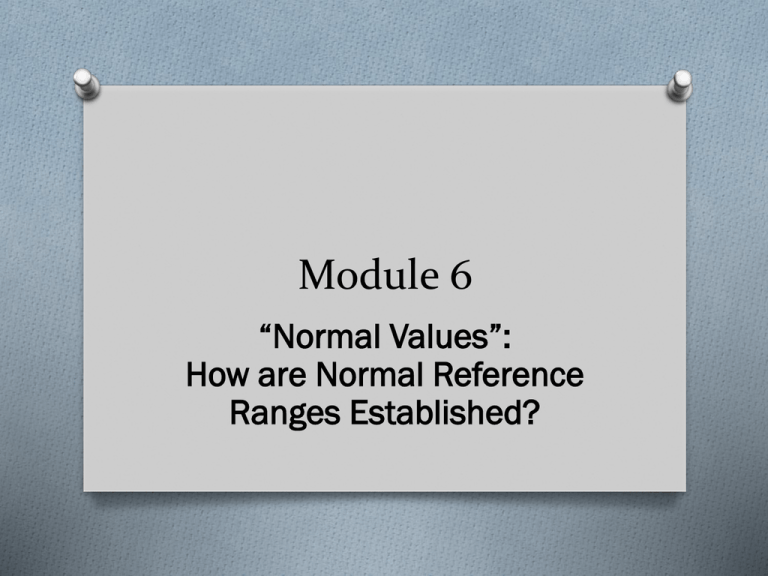
Module 6 “Normal Values”: How are Normal Reference Ranges Established? Doctor, was my test normal? Reference Ranges O Comparison of a patient’s laboratory test result versus a reference or “normal” range is an important aspect of medical decision making O Reference Ranges are required by professional accreditation and regulatory standards Reference Ranges O Laboratory directors determine and evaluate reference ranges reported with all test results O In most cases, a “normal range” is used as the test’s “reference range”. O For some analytes, the reference range is defined as “less than” or “greater than” a certain value O Example: total cholesterol: <200mg is desirable Establishing Reference Ranges O When selecting the decision threshold or cutoff value (a limit above or below which a patient is considered affected by a particular disease, i.e., normal or abnormal), a variety of methods can be used. Gaussian Distribution O If test results from a normal healthy patient population fall into a bell-shaped, Gaussian, normal distribution, the central 95% is usually used as the test’s normal range. O For many (but not all) tests, this is how the range of tests results for normal healthy individuals is determined. Some Normals are Abnormal …… and Vice Versa O The normal range encompasses the mean plus or minus two standard deviations or, again, about 95% of normal, healthy individuals’ test results. O However, 5% (roughly 1 out of 20) normal healthy patients may be outside the cutoff value. O Roughly 2.5% of normal people can be expected to have a result below and roughly 2.5% of normal people can be expected to have a result above the reported normal range. O This situation is encountered with almost all tests. O This is because the distribution of tests results from normal, healthy individuals overlaps with the distribution of test results from sick patients with the relevant disease. Two Populations of Results O Theoretically, the better tests minimize this overlap between the distribution of normal and abnormal test results. O An ideal test would have no overlap at all and could perfectly discriminate between a normal and abnormal test result. O Lab experts continue to look for at least one test like this ……. Non-Gaussian Distributions O For non-Gaussian distributions, lab directors can use other nonparametric techniques to establish reference range limits O Example: set upper and lower limits of normal to include 95% of the population after all of the test results have been transformed into logarithms taking the central 95% of the transformed data. Where’s the Threshold or Cut-off? O Ultimately, where the lab places the limits (threshold or cut-off) on a normal or reference range determines what level of result is considered “normal” or “abnormal”. O In the next slide, the values for the concentration of a hypothetical analyte were determined in a group of 200 healthy persons and in a group of 50 diseased persons. The raw data for the group were fitted to Gaussian distributions. O A through D represent possible cutoff values that could be used to classify subjects based on the analyte values. Distribution of a Test Result in Healthy (n=200) and Diseased (n=50) Persons Frequency Healthy Persons Cutoffs A B C D Diseased Persons 10 20 30 40 50 60 70 80 90 100 110 120 130 Analyte Value (units) O What would be the advantage(s) of selecting A as the cut off value for “normal”? O All patients with the disease would have a positive test result O What would be the advantage(s) of selecting D as the cut-off value? O All healthy patients would have a negative test result O What would be the disadvantage(s) of selecting D as the cut off? O Persons with the disease may not be diagnosed O What would be the disadvantage(s) of selecting A as the cut-off? O Patients who do not have the disease would be classified as having an “abnormality” Consider the implications if this were a screening test for cancer…. Image by Theresa Kristopaitis, MD Recall the Definitions of Sensitivity and Specificity O Sensitivity is the ability of a test to detect disease O Proportion of persons with disease in whom the test is positive O Specificity is the ability to detect the absence of disease O Proportion of persons without disease in whom the test is negative Predictive Value Grid Test Result Disease or Sick No Disease (Normal, Healthy) Positive Result* True Positives False Positives Negative Result* False Negatives True Negatives TOTAL *“positive” usually refers to a test being abnormal, “negative” usually refers to normal Does this Grid Reflect Cut-off Value A or D? Test Result Disease or Sick No Disease (Normal, Healthy) Positive Result* True Positives False Positives 50 Negative Result* TOTAL False Negatives 25 True Negatives 0 175 50 200 Answer – Cutoff Value A The sensitivity of the test would be 100% HOWEVER The specificity of the test would be 87% O Sensitivity and specificity therefore are not fixed characteristics of a test and must be calculated for each cutoff chosen O When a test cutoff is altered, an inverse relationship between sensitivity and specificity is noted Where’s the Threshold or Cut-off? O To reiterate, where the lab places the threshold or cut-off on a normal or reference range determines what level of result is considered “normal” or “abnormal”. O It also affects the distribution of values and how they are tallied in the predictive value grid and resultant diagnostic value of a test O It affects the care of patients and may have serious implications Congratulations! You have completed the “Introduction to Laboratory Medicine” modules!







